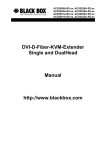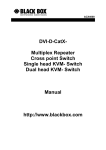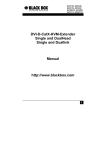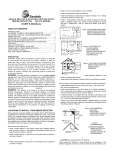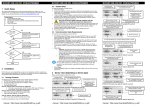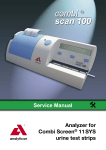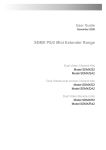Download Welcome to the DVXi/ET KVM-Extender Family!
Transcript
DVXI/ET-XX KVM-EXTENDER Welcome to the DVXi/ET KVM-Extender Family! Thank you for purchasing a DVXi/ET KVM-Extender! We appreciate your business, and we think you’ll appreciate the many ways that your enhanced RGB Graphic system will save you money, time, and effort. That’s because our DVXi/ET KVM-Extender is all about breaking away from the traditional model of attaching a new display to DVI graphic source. Using the DVXi/ET KVMExtender, you can remotely locate monitor, keyboard and mouse up to 140m away from your CPU. Wherever long distances are usual, e.g. airports, industrial plants, call- centres or in distributed computer centres, the DVXi/ET KVM-Extender is the best way, to solve all problems in remotely locating your console. 8 different types are available: Singlehead and Dualhead devices for PS2 keyboard/mouse and Singlehead and Dualhead devices for USB keyboard/mouse. Audio/serial Options are also available for each device. This manual will tell you all about your new DVXi/ET KVM-Extender, including how to install, operate, and troubleshoot it. For an introduction to the Converter, see Chapter 2. The Converter product codes covered in this manual are: Devices for CATx Cables K461-1W: DVXi/ET-PC KVM-Extender for 1x DVI, PS2-Keyboard/Mouse K461-2W: DVXi/ET-PC2 KVM-Extender for 2x DVI, PS2-Keyboard/Mouse K461-1U: DVXi/ET-UC KVM-Extender for 1x DVI, USB-Keyboard/Mouse K461-2U: DVXi/ET-UC2 KVM-Extender for 2x DVI, USB-Keyboard/Mouse K461-SA: DVXi/ET-PCA KVM-Extender for 1x DVI, PS2- Keyboard/Mouse + Serial/Audio K461-DA: DVXi/ET-PCA2 KVM-Extender for 2x DVI, PS2- Keyboard/Mouse + Serial/Audio K461-SU: DVXi/ET-UCA KVM-Extender for 1x DVI, USB- Keyboard/Mouse + Serial/Audio K461-DU: DVXi/ET-UCA2 KVM-Extender for 2x DVI, USB- Keyboard/Mouse + Serial/Audio 1 DVXI/ET-XX KVM-EXTENDER Devices for Multimode fibres K462-1W: DVXi/EM-PC KVM-Extender for 1x DVI, PS2-Keyboard/Mouse K462-2W: DVXi/EM-PC2 KVM-Extender for 2x DVI, PS2-Keyboard/Mouse K462-1U: DVXi/EM-UC KVM-Extender for 1x DVI, USB-Keyboard/Mouse K462-2U: DVXi/EM-UC2 KVM-Extender for 2x DVI, USB-Keyboard/Mouse K462-SA: DVXi/EM-PCA KVM-Extender for 1x DVI, PS2- Keyboard/Mouse + Serial/Audio K462-DA: DVXi/EM-PCA2 KVM-Extender for 2x DVI, PS2- Keyboard/Mouse + Serial/Audio K462-SU: DVXi/EM-UCA KVM-Extender for 1x DVI, USB- Keyboard/Mouse + Serial/Audio K462-DU: DVXi/EM-UCA2 KVM-Extender for 2x DVI, USB- Keyboard/Mouse + Serial/Audio Devices for Singlemode fibres 2 K463-1W: DVXi/ES-PC KVM-Extender for 1x DVI, PS2-Keyboard/Mouse K463-2W: DVXi/ES-PC2 KVM-Extender for 2x DVI, PS2-Keyboard/Mouse K463-1U: DVXi/ES-UC KVM-Extender for 1x DVI, USB-Keyboard/Mouse K463-2U: DVXi/ES-UC2 KVM-Extender for 2x DVI, USB-Keyboard/Mouse K463-SA: DVXi/ES-PCA KVM-Extender for 1x DVI, PS2- Keyboard/Mouse + Serial/Audio K463-DA: DVXi/ES-PCA2 KVM-Extender for 2x DVI, PS2- Keyboard/Mouse + Serial/Audio K463-SU: DVXi/ES-UCA KVM-Extender for 1x DVI, USB- Keyboard/Mouse + Serial/Audio K463-DU: DVXi/ES-UCA2 KVM-Extender for 2x DVI, USB- Keyboard/Mouse + Serial/Audio DVXI/ET-XX KVM-EXTENDER Copyrights and Trademarks ©2008. All rights reserved. This information may not be reproduced in any manner without the prior written consent of the manufacturer. Information in this document is subject to change without notice and the manufacturer shall not be liable for any direct, indirect, special, incidental or consequential damages in connection with the use of this material. All trademark and trade names mentioned in this document are acknowledged to be the property of their respective owners. Disclaimer While every precaution has been taken in the preparation of this manual, the manufacturer assumes no responsibility for errors or omissions. Neither does the manufacturer assume any liability for damages resulting from the use of the information contained herein. The manufacturer reserves the right to change the specifications, functions, or circuitry of the product without notice. The manufacturer cannot accept liability for damage due to misuse of the product or due to any other circumstances outside the manufacturer’s control (whether environmental or installation related). The manufacturer shall not be responsible for any loss, damage, or injury arising directly, indirectly, or consequently from the use of this product. Cautions and Notes The following symbols are used in this guide: CAUTION: This indicates an important operating instruction that should be followed to avoid any potential damage to hardware or property, loss of data, or personal injury. NOTE. This indicates important information to help you make the best use of this product. 3 DVXI/ET-XX KVM-EXTENDER . 4 DECLARATION OF CONFORMITY EC DECLARATION OF CONFORMITY The products listed below in the form as delivered are in conformity with the provisions of the following European Directives: 2004/108/EG Council Directive on the approximation of the laws of the Member States relating to electromagnetic compatibility CE-marking 2009 Product list: K461-1W, K461-2W, K461-1U, K461-2U, K461-SA, K461-DA, K461-SU, K461-DA K462-1W, K462-2W, K462-1U, K462-2U, K462-SA, K462-DA, K462-SU, K462-DA K463-1W, K463-2W, K463-1U, K463-2U, K463-SA, K463-DA, K463-SU, K463-DA Conformity to the Directives is assured through the application of the following standards: EN 55022: IEC 61000-4-2: IEC 61000-4-3: IEC 61000-4-4: IEC 61000-4-5: 09/2006 Class A 02/2001 05/2006 12/2004 11/2006 This declaration certifies the conformity to the specified directives but contains no assurance of properties. The safety documentation noted in this manual shall be considered in detail. The length of the attached CPU- or Console Cables must not exceed 3m. The use of suggested interconnect cables is mandatory. rd Oberteuringen, June 23 , 2009 The management manufacturer: IHSE GmbH Maybachstrasse 11 88094 Oberteuringen Germany WARNING: This equipment has been found to comply with the limits for a Class A digital device, pursuant to Part 15 of the FCC Rules. These limits are designed to provide reasonable protection against harmful interference when the equipment is operated in a commercial environment. This equipment generates, uses, and can radiate radio frequency energy and, if not installed and used in accordance with the instruction manual, may cause harmful interference to radio communications. Operation of this equipment in a residential area is likely to cause harmful interference in which case the user will be required to correct the interference at his own expense. 5 DVXI/ET-XX KVM-EXTENDER Safety Precautions and Installation Guidelines To ensure reliable and safe long-term operation, please note the following installation guidelines: • Do not use CATx-devices to link between buildings – please use fibre devices. • Only use in dry, indoor environments. • If the building has 3-phase AC power, try to ensure that equipment connected to the Local and Remote units is on the same phase. • Try not to route a CATx link cable alongside power cables. • The Remote unit, Local unit and any power supplies can get warm. Do not locate them in an enclosed space without any airflow. • Do not place a power supplies directly on top of a unit. • Do not obstruct a unit’s ventilation existing holes. To safeguard against personal injury and avoid possible damage to equipment or property, please observe the following: 6 • Only use power supplies originally supplied with the product or manufacturer-approved replacements. Do not attempt to dismantle or repair any power supply. Do not use a power supply if it appears to be defective or has a damaged case. • Connect all power supplies to grounded outlets. In each case, ensure that the ground connection is maintained from the outlet socket through to the power supply’s AC power input. • Do not attempt to modify or repair this product, or make a connection from the interconnection link interface to any other products, especially telecommunications or network equipment. INHALTSVERZEICHNIS Contents 1. Quick Setup 8 2. Overview 9 2.1 2.2 2.3 2.4 2.5 2.6 2.7 Introduction Glossary Example of a DVXi/ET KVM-Extender System Features Product Range Compatibility How to Use This Guide 3. Installation 3.1 3.2 3.3 3.4 Package Contents Interconnection Cable Requirements System Setup Diagnostic LEDs 4. Service Setup 4.1 4.2 Setup at the Local Unit Setup at the Remote Unit 9 9 10 11 12 14 15 16 16 18 20 31 32 33 35 5. Troubleshooting 36 Appendix A: Example Applications 40 Appendix B: Rack Mount Options 42 Appendix C: Devices w/ serial/AUDIO Option 46 Appendix D: Calling Technical Support 48 Appendix E: List of supported USB devices 49 Appendix F: Specifications 50 Appendix G: Connectors 53 7 DVXI/ET-XX KVM-EXTENDER 1. Quick Setup This section briefly describes how to install your DVXi/ET KVM extender system. Unless you are an experienced user, we recommend that you follow the full procedures described in the rest of this manual. Install system 1. 2. 3. 4. Connect Remote unit to KVM. Connect Local unit to CPU or switch. Connect Local and Remote units with matching interconnection cable (CATx or Fiber). Power up the system. NO Power LED illuminated? YES Check p.s.u.’s and connection to power outlet NO Link LED illuminated? Check the CATx/Fiber cable, and CATx/Fiber connectors YES Video OK LED illuminated? YES Done 8 NO Check settings of graphic card or boot CPU OVERVIEW 2. Overview 2.1 Introduction A KVM Extender is used, to extend the distance between a CPU and his Keyboard / Monitor / Mouse considerably. In addition they are irrecoverable in installations in electromagnetic hazardous environments (EMI). Normal Keyboard-/ Monitor-/ Mouse extender cables (and Extender using traditional cables) cannot go so far and EMI interferences may reduce the maximum distance and/or reliability. Using a DVXi/ET Extender system, these limitations are past. Remain your CPU in a secure rack cabinet or data centre while accessing from a 140m (CATx) up to 10.000m (Singlemode) remotely located place. A basic KVM extension system comprises a Local unit and a Remote unit. The Local unit connects directly to the CPU (or a KVM switch system) using the supplied cable(s). The user console (keyboard, mouse and monitor) attaches to the Remote unit. The Remote and Local units communicate video and data information along the interconnecting cable. Local units offer dual access, allowing the connection of a second user console close to the computer. 2.2 Glossary The following terms are used in this guide: CATx Any Category 5, 5e, 6 or higher cable, solid wires type AWG24. Fiber Singlemode or Multimode fiber cable. Singlemode 9µ Singlemode-fiber cable Multimode 62,5µ Multimode- or 50µ Multimode-fiber cable KVM Keyboard, Video and Mouse. Console Keyboard, Mouse and Monitor Dual Access A system allowing connection of Local and Remote user consoles. Singlehead An extender system that supports one monitor + Keyboard/Mouse Dualhead An extender system that supports two monitors + Keyboard/Mouse DVI Digital Video standard, installed by Digital Display Working Group (www.ddwg.org) R, G, B, CLOCK in a data stream with up to 3x 1,6 Gbit/sec. Signals are TMDS Level. PSU The desktop power supply connected to the Local/Remote unit. HID Human Interface Devices are units, which are used for human access to the CPU. They are a USB-device class of its own (e.g. Memory Devices etc.). Besides of keyboard and mouse also touchscreen, light pen, fingerprint sensor, graphic tablets etc. are HID devices. 9 DVXI/ET-XX KVM-EXTENDER 2.3 Example of a DVXi/ET KVM-Extender System CPU with DVI-D Graphic card Local Console Optional 2. Monitor DVXi/ET KVMExtender system Remote Console Optional 2. Monitor DVXi/ET – KVM Extender system (example) 10 OVERVIEW 2.4 Features All members of the DVXi/ET - DVI KVM Extender Series offer the following features: • Support for DVI-D Graphic cards (all devices) • Support for PS2-Keyboard and PS2-Mouse (K46x-1W, K46x-SA, K46x-2W and K46xDA) • Support for USB-Keyboard and USB-Mouse (K46x-1U, K46x-SU, K46x-2U and K46xDU) • Support for two monitors per system (K46x-2W, K46x-2U, K46x-DA and K46x-DU) Devices with USB- connectors support ONLY Keyboard and Mouse. It’s possible, that other HID devices (Human Interface Device) like touchscreens, graphics tablets, barcode readers or similar are supported – but there is no guarantee for this! The DVI-D CATx KVM-Extender is NOT suitable for use with other USB devices like Scanner, WEB- Cams, data sticks etc. The device never supports more than two devices – Keyboard and Mouse or Keyboard and Touchscreen, etc. but not e.g. Keyboard, Mouse and Touchscreen simultaneously. A Hub is allowed but does not raise the number of supported devices • Maximum resolution: DVI-D: 1920x1200@60Hz over all allowed distances all lower resolutions with refresh rates of at least 75Hz • Supporting 16 Bit/24 Bit auto switching or fixed 24 Bit color depth (user selectable) • Optional: On Single head devices, transparent serial port enables any serial device to be extended (up to 19.2K Baud). The serial port may be used to extend one device (requiring handshaking lines) or up to three simple serial devices (no handshaking). Dualhead Units support Tx/Rx only (XON/XOFF) • Optional support of a bidirectional audio interface. • Status indicator LEDs on each device. • Small footprint chassis. • Rack mount options available. • CPU cables + Adapters included. 11 DVXI/ET-XX KVM-EXTENDER 2.5 Product Range DVXi/ET – Extender (CATx Cables) K461-1W DVXi/ET-PC KVM-Extender 1x DVI, PS2-Keyboard, PS2-Mouse (Singlehead) K461-2W DVXi/ET-PC2 KVM-Extender 2x DVI, PS2-Keyboard, PS2-Mouse s (Dualhead) K461-1U DVXi/ET-UC KVM-Extender 1x DVI, USB-Keyboard, USB-Mouse (Singlehead) K461-2U DVXi/ET-UC2 KVM-Extender 2x DVI, USB-Keyboard, USB-Mouse (Dualhead) K461-SA DVXi/ET-PCA KVM-Extender 1x DVI, PS2-Keyboard, PS2-Mouse (Single Head) + Audio/serial K461-DA DVXi/ET-PC2A KVM-Extender 2x DVI, PS2-Keyboard, PS2-Mouse (Dual Head) + Audio/serial K461-SU DVXi/ET-UCA KVM-Extender 1x DVI, USB-Keyboard, USB-Mouse (Single Head) + Audio/serial K461-DU DVXi/ET-UC2A KVM-Extender 2x DVI, USB-Keyboard, USB-Mouse (Dual Head) + Audio/serial DVXi/ET – Extender Multimode Cables K462-1W DVXi/EM-PC KVM-Extender 1x DVI, PS2-Keyboard, PS2-Mouse (Singlehead) K462-2W DVXi/EM-PC2 KVM-Extender 2x DVI, PS2-Keyboard, PS2-Mouse s (Dualhead) K462-1U DVXi/EM-UC KVM-Extender 1x DVI, USB-Keyboard, USB-Mouse (Singlehead) K462-2U DVXi/EM-UC2 KVM-Extender 2x DVI, USB-Keyboard, USB-Mouse (Dualhead) K462-SA DVXi/EM-PCA KVM-Extender 1x DVI, PS2-Keyboard, PS2-Mouse (Single Head) + Audio/serial K462-DA DVXi/EM-PC2A KVM-Extender 2x DVI, PS2-Keyboard, PS2-Mouse (Dual Head) + Audio/serial K462-SU DVXi/EM-UCA KVM-Extender 1x DVI, USB-Keyboard, USB-Mouse (Single Head) + Audio/serial K462-DU DVXi/EM-UC2A KVM-Extender 2x DVI, USB-Keyboard, USB-Mouse (Dual Head) + Audio/serial 12 OVERVIEW DVXi/ET – Extender (Singlemode Cables) K463-1W DVXi/ES-PC KVM-Extender 1x DVI, PS2-Keyboard, PS2-Mouse (Singlehead) K463-2W DVXi/ES-PC2 KVM-Extender 2x DVI, PS2-Keyboard, PS2-Mouse s (Dualhead) K463-1U DVXi/ES-UC KVM-Extender 1x DVI, USB-Keyboard, USB-Mouse (Singlehead) K463-2U DVXi/ES-UC2 KVM-Extender 2x DVI, USB-Keyboard, USB-Mouse (Dualhead) K463-SA DVXi/ES-PCA KVM-Extender 1x DVI, PS2-Keyboard, PS2-Mouse (Single Head) + Audio/serial K463-DA DVXi/ES-PC2A KVM-Extender 2x DVI, PS2-Keyboard, PS2-Mouse (Dual Head) + Audio/serial K463-SU DVXi/ES-UCA KVM-Extender 1x DVI, USB-Keyboard, USB-Mouse (Single Head) + Audio/serial K463-DU DVXi/ES-UC2A KVM-Extender 2x DVI, USB-Keyboard, USB-Mouse (Dual Head) + Audio/serial Upgrade Kits 455-4G 19”/1HE Rackmount- Kit to mount up to 4 Singlehead devices 455-8G 19”/1HE Rackmount- Kit to mount up to 4 Dualhead devices 455-PS 19“ mountable power supply for up to three DVXI devices. 455-1K Mounting plate to mount by screws 455-2K Mounting plate to mount by snap on Acessories K469-DV DVI-D to VGA converter, to attach the local output to a traditional VGA-KVM-Switch K470-CW CWDM MUX/DEMUX to send up to 4 DVXi data links across a single pair of Singlemode fibers K471-CT CATx Repeater to double the total allowed distance to 280m (Also available for Multi-/Singlemode) K471-CM CATx/Multimode Cross Repeater to convert from CATx to Multimode or back K471-CS CATx/Multimode Cross Repeater CATx to Singlemode … 13 DVXI/ET-XX KVM-EXTENDER 2.6 Compatibility Interface Compatibility • Digital Video (DVI-D): Digital Video standard, installed by Digital Display Working Group (www.ddwg.org) R, G, B, CLOCK in a data stream with up to 3x1,6 Gbit/sec. Signals are TMDS Level. • PS/2 Keyboard: Compatible with all standard keyboards. Certain keyboards with enhanced features may also be supported with custom firmware. • PS/2 Mouse: Compatible with all standard 2-button, 3-button and wheel mice. • USB Keyboard: Compatible with all standard keyboards. Certain keyboards with enhanced features may also be supported with custom firmware. Keyboards with built-in hub are also supported – but there are never more than two HID devices supported. • USB Mouse: Compatible with all standard 2-button, 3-button and wheel mice. Devices with USB- connectors support ONLY Keyboard and Mouse. It’s possible, that other HID devices (Human Interface Device) like touchscreens, graphics tablets, barcode readers or similar are supported – but there is no guarantee for this! The DVI-D CATx KVM-Extender is NOT suitable for use with other USB devices like Scanner, WEB- Cams, data sticks etc. The device never supports more than two devices – Keyboard and Mouse or Keyboard and Touchscreen, etc. but not e.g. Keyboard, Mouse and Touchscreen simultaneously. A Hub is allowed but does not raise the number of supported devices 14 OVERVIEW 2.7 How to Use This Guide This guide describes the installation and configuration of the DVXi/ET – Extender Series. Although the connection and operation of the system is relatively straightforward, you should consider the following before getting started: Connection & Compatibility If you have purchased an Extender Kit, this will contain all the cables required to connect the Local unit to your PC or KVM switch. Please see also: Package Contents (page 16) Devices with PS2 connectors are NOT compatible to devices with USB connectors. For information about connection and installation, see Installation, page 16. DDC Information Normally it is not necessary to make any adjustments to the DVXi- Extender. However, in some circumstances, it may be necessary to redefine the source of DDC Information for the CPU. By default, the DVXi/ET KVM-Extender uses its own internal DDC table. If this setting does not satisfy your requirements, the DDC table can either be switched to the locally attached screen or could be downloaded from remotely located screen and stored in the internal DDC table. To modify the DDC-Setup, see Service Setup (page 32). Selecting the moment of switching to the next frame The transmission of screen data in not synchronous to the screen change of the graphic card. Normally, the transmission is terminated during displaying a frame on the screen. If the device switches to the new frame during the displaying period of the old frame (somewhere on the screen), it’s possible, that you can see horizontal screen breaks in the moment of switching (default). On the other hand the device must idle, until the actual frame is displayed completely (until VSYNC) -> the number of frames per second transmitted sinks. To modify the switching behaviour, see Service Setup (page 32). Selection of Color reduction for transfer acceleration You can select, whether always 24 Bit colors (=full color depth) are transmitted or whether the compression algorithm automatically switches between 16 and 24 Bit colors to accelerate the data transfer (default). Normally the difference between 24 Bit and 16 Bit is not recognizable but under some special circumstances e.g. in photo processing installations there might be disturbing color abberations. However, the automatic color switching enhances the count of frames, transmitted per second, fixed 24 Bit color depth gives smooth color grades under all circumstances. Please select to you choice the better mode. To modify the color depth, see Service Setup (page 32). 15 DVXI/ET-XX KVM-EXTENDER 3. Installation For first-time users, we recommend that you carry out a test placement, confined to a single room, before commencing full installation. This will allow you to identify and solve any cabling problems, and experiment with the KVM extender system more conveniently. 3.1 Package Contents You should receive the following items in your extender package (all types): • DVXi/ET KVM-Extender- pair (Local Unit + Remote Unit) • 2x 5V DC universal power supply for the DVXi/ET - Extender • 2x German type power cord • User manual (Quick Setup) K461-1W, K461-SA, K461-2W and K461-DA (additionally): • KVM CPU cable set (1.8m) with one side: PS/2 (6-pin mini-DIN male) keyboard and mouse connector and DVI-D video (DVI-D dual link male) connector – other side: DVID video (DVI-D dual link male) connector • PS2-Keyboard-/ Mouse adapter to connect K/M to the Local Unit (keyboard can be plugged in directly, without using an adapter) 16 INSTALLATION K461-1W, K461-SU, K461-2W and K461-DU (additionally): • DVI-D (1,8m) video cable (DVI-D dual link male-to-male) • USB (1,8m) cable (USB type A to type B) K461-2W, K461-DA, K461-2U and K461-DU (additionally): • DVI-D (1,8m) video cable (DVI-D dual link male-to-male) K461-SA and K461-SU (additionally): • Serial link cable (1.8m) with one side DSUB9pin male connector – other side DSUB9pin female connector – 1:1 • 2x audio cable (1.8m, 3.5mm stereo plugs) K461-DA and K461-DU (additionally): • 1x Serial link/ audio ZIP-type cable (1.8m) with one side DSUB9pin female connector + 2x 3.5mm stereo plugs – other side miniDIN8pin male connector If anything is missing, please contact Technical Support (see Appendix F – Calling Technical Support). 17 DVXI/ET-XX KVM-EXTENDER 3.2 Interconnection Cable Requirements To connect the Local and Remote units you will need: • DVI, PS2-Keyboard, and PS2-Mouse: Connect the supplied KVM CPU cable set to your CPU (KVM - Switch, etc.). Please ensure that the connection is tension-free! Devices K461-1W, K461-2W, K461-SA and K461-DA • DVI, USB-Keyboard, USB-Mouse: Connect the supplied DVI-D cable (DVI-D to DVI-D) and the USB-cable (USB-A to USB-B) to your CPU. Please ensure that the connection is tension-free! Devices K461-1U, K461-2U, K461-SU and K461-DU • DVI: Connect the supplied DVI CPU cable set to your CPU (KVM - Switch, etc.). Please ensure that the connection is tension-free! Devices K461-2W, K461-2U, K461DA and K461-DU • serial/audio: Connect the supplied serial/audio cable set to your CPU (8pin miniDIN male to serial DB9-male/female and 2c 3.5mm audio). • Serial: Connect the supplied serial cable to your CPU. • Audio: Connect the supplied audio cable to your CPU. • CATx Cable: Recommended cable: S/UTP (Cat5) according EIA/TIA 56A, TSB 36 or Digital STP 17-03170. Four pairs AWG 24. connection according EIA/TIA 568A (10BaseT). Use of cables from a higher category (Cat5e, Cat6, Cat7) is possible. The use of unshielded CATx Cable is possible, because of the higher electromagnetic noise/sensitivity the device class may not be reached. The use of flexible Cables (Patch cable) Type AWG26/8 is possible. Because of the higher loss of the stranded cables, the maximum distance is reduced to app. half the value of solid cables. A point to point connection is required. Having one or more patch panels in the line is possible and allowed. Not allowed is a connection from the CATx link interface (RJ45) to any other products, especially telecommunications or network equipment. 18 INSTALLATION • Fiber Cable: Two strands of fiber are required for singlehead devices, four strands for Dualhead devices. Please note, that the allowed distance will depend on device type AND on used fiber type. • Recommended cables: K462-xx: Multimode type 50/125µ K462-xx: Multimode type 62.5/125µ K463-xx: Singlemode type 9/125µ allowed distance app. 400m (1,300ft) allowed distance app. 200m (650ft) allowed distance app. 10km (32,750ft) A point to point connection is required. Having one or more patch panels in the line is possible and allowed. Not allowed is a connection from the Fiber link interface (LC) to any other products, especially telecommunications or network equipment. Our experiences show, that Singlemode devices regularly work well on Multimode Fibers where vice versa it will never do. In addition we found, that Singlemode devices on Multimode fibers may extend the allowed distance on Multimode fibers to twice the regular length. Anyway this cannot be guaranteed and must be evaluated by the end-user at his own expense. • Power Supply: Connect the supplied 5V/DC power supplies to the Plug terminal on the rear of both local and remote units. 19 DVXI/ET-XX KVM-EXTENDER 3.3 System Setup To install your DVXi/ET – Extender system: 1. Switch off all devices. 2. Connect your keyboard, monitor(s) and mouse to the Remote unit (depending on device type). Please ensure, to not swap Mouse- and Keyboard connector. The (PS2-) Keyboard connector is purple and the (PS2-) Mouse connector is green. 3. Using the supplied CPU KVM cable(s), connect the keyboard, monitor(s) and mouse connectors on the computer (or KVM switch). Please ensure, to not swap Mouse- and Keyboard connector. The (PS2-) Keyboard connector is purple and the (PS2-) Mouse connector is green. 4. Connect the interconnect cable to the INTERCONNECT socket(s) 5. Connect the 5V power supply to power the unit. Only use the power supply originally supplied with this equipment or a manufacturer-approved replacement. 6. For a dual access system, connect the monitor for the Local console to the appropriate port on the Local unit. The port may also be used to feed into a KVM switch. To the local (PS2-) Keyboard-/ Mouse port you can attach a Keyboard directly or Mouse/ Keyboard together, using the delivered adapter. To attach a local (USB-) Keyboard/Mouse, please use additional USB port(s) at your CPU or use a USB Hub in-between CPU and local unit’s USB connector. 7. 20 Power up the system. INSTALLATION Connect to CPU: DVI, keyboard, mouse Local DVI-Monitor port Connect to Local console monitor Local keyboard/ mouse port Solely Keyboard may be plugged in directly, keyboard/mouse through equipped adapter DVXi/ET KVM-Extender Type K461-1W Local Unit Remote DVI-Monitor port– connect to Remote console monitor Remote keyboard port Remote mouse port DVXi/ET KVM-Extender Type K461-1W Remote Unit Connect to CPU: DVI graphic card Local DVI-Monitor port Connect to Local console monitor Connect to CPU: USB DVXi/ET KVM-Extender Type K461-1U Local Unit 21 DVXI/ET-XX KVM-EXTENDER Remote DVI-Monitor port– connect to Remote console monitor Remote keyboard/mouse port DVXi/ET KVM-Extender Type K461-1U Remote Unit Connect to 5V Power supply INTERCONNECT – carries video and data signals – connect to Local/ remote unit with CATx cable DVXi/ET KVM-Extender Type K461-1W and K461-1U Local/ Remote Unit Connect to 5V Power supply INTERCONNECT – carries video and data signals – connect to Local/ remote unit with Fiber cable DVXi/ET KVM-Extender Type K462-1W/-1U and K463-1W/-1U Local/ Remote Unit 22 INSTALLATION To CPU: DVI Local DVI-Monitor port Connect to Local console monitor Audio In To CPU: Serial Local keyboard/mouse port; Solely Keyboard may be plugged in directly, keyboard/mouse through equipped adapter DVXi/ET KVM-Extender Type K461-SA Local Unit Audio Out Remote DVI-Monitor port– connect to Remote console monitor Serial Out Remote keyboard port Remote mouse port DVXi/ET KVM-Extender Type K461-SA Remote Unit 23 DVXI/ET-XX KVM-EXTENDER To CPU: DVI Audio In To CPU: Serial Local DVI-Monitor port Connect to Local console monitor To CPU: USB DVXi/ET KVM-Extender Type K461-SU Local Unit Audio Out Remote DVI-Monitor port– connect to Remote console monitor Serial Out Remote keyboard/mouse port DVXi/ET KVM-Extender Typ K461-SU Remote Unit 24 INSTALLATION Connect to 5V Power supply INTERCONNECT – carries video and data signals – connect to Local/ remote unit with CATx cable DVXi/ET KVM-Extender Type K461-SA and K461-SU Local/ Remote Unit Connect to 5V Power supply INTERCONNECT – carries video and data signals – connect to Local/ remote unit with Fiber cable Fiber-Plug type: LC DVXi/ET KVM-Extender Type K462-SA/-SU and K463-SA/-SU Local/ Remote Unit 25 DVXI/ET-XX KVM-EXTENDER Connect to CPU: 2 DVI-Graphic card nd Connect to CPU: 1st DVI-Graphic card, keyboard, mouse 2nd local DVI-Monitor port Connect to Local console 2nd monitor Local DVI-Monitor port Connect to Local console monitor Local keyboard/ mouse port Solely Keyboard may be plugged in directly, keyboard/mouse through equipped adapter DVXi/ET KVM-Extender Type K461-2W Local Unit 2nd remote DVI-Monitor port Connect to Remote console 2nd monitor 1st remote DVIMonitor port– connect to Remote console 1st monitor Remote keyboard port DVXi/ET KVM-Extender Type K461-2W Remote Unit 26 Remote mouse port INSTALLATION Connect to CPU: 2nd DVI-Graphic card Connect to CPU: 1 DVI-Graphic card st 2nd local DVI-Monitor port Connect to Local console 2nd monitor local 1st DVI-Monitor port Connect to Local console 1st monitor Connect to CPU: USB DVXi/ET KVM-Extender Type K461-2U Local Unit 2nd remote DVI-Monitor port Connect to Remote console 2nd monitor 1st remote DVIMonitor port– connect to Remote console 1st monitor Remote keyboard/ mouse port DVXi/ET KVM-Extender Type K461-2U Remote Unit 27 DVXI/ET-XX KVM-EXTENDER Connect to CPU: 2nd DVI-Graphic card Connect to CPU: 1st DVI-Graphic card 2nd local DVI-Monitor port Connect to Local console 2nd monitor Local 1st DVI-Monitor port Connect to Local console 1st monitor Connect to CPU: serial/ audio ports Local keyboard/ mouse port; Solely Keyboard may be plugged in directly, keyboard/mouse through equipped adapter DVXi/ET KVM-Extender Type K461-DA Local Unit 2nd remote DVIMonitor port Connect to Remote console 2nd monitor 1st remote DVIMonitor port– connect to Remote console 1st monitor Audio Out Remote keyboard port Serial Out Remote mouse port DVXi/ET KVM-Extender Type K461-DA Remote Unit 28 INSTALLATION Connect to CPU: 2nd DVI-Graphic card Connect to CPU: 1st DVI-Graphic card Connect to CPU: serial/ audio ports 2nd local DVI-Monitor port Connect to Local console 2nd monitor Local 1st DVI-Monitor port Connect to Local console 1st monitor Connect to CPU: USB DVXi/ET KVM-Extender Type K461-DU Local Unit Connect to CPU: DVI-cable set (2nd DVI-Graphic card, audio, serial) 1st remote DVIMonitor port– connect to Remote console 1st monitor Audio Out Serial Out Remote keyboard/ mouse port DVXi/ET KVM-Extender Type K461-DU Remote Unit 29 DVXI/ET-XX KVM-EXTENDER INTERCONNECT – carries 2nd video – connect to Local/Remote unit with CATx cable Connect to 5V Power supply INTERCONNECT – carries 1st video and data signals – connect to Local/ Remote unit with CATx cable DVXi/ET KVM-Extender Type K461-2W, K461-2U K461-DA and K461-DU Local/ Remote Unit INTERCONNECT – carries 2nd video – connect to Local/Remote unit with Fiber cable Fiber-Plug type: LC Connect to 5V Power supply INTERCONNECT – carries 1st video and data signals – connect to Local/ Remote unit with Fiber cable Fiber-Plug type: LC DVXi/ET KVM-Extender Type K462-2W/-2U, K463-2W/2U K462-DA/-DU and K463-DA/-DU Local/ Remote Unit 30 INSTALLATION 3.4 Diagnostic LEDs Each DVXi/ET KVM-Extender is fitted with four indicator LEDs: Power, Video OK, Data Error, Link Status: The Power LEDs are next to the Power socket. The location of the LEDs is shown below: Diagnostic LED Power Diagnostic LED Video OK Diagnostic LED Data Error Diagnostic LED Link Status Diagnostic - LEDs at DVXi/ET - Extender LED Appearance Diagnostics Power LED (Red LED) Off On Device not ready Device ready Video Okay (Green LED) Off On No or invalid video signal detected Device ready Link Status (Green LED) blinking On No INTERCONNECT connection Device ready Data Error (Green LED) Off blinking / On Device ready Errors through data transmission over INTERCONNCT Cable (Cable too long, too high attenuation or too much EMI interferences ) 31 DVXI/ET-XX KVM-EXTENDER 4. Service Setup For most applications, you shouldn't need not to make any adjustments to set up your DVXi/ET KVM -Extender. Under some special circumstances it could be necessary to setup configuration specials. For some applications, you may need to open the Local Unit and/or the Remote Unit. Unscrew the Philips-type screws at both sides at the bottom of the device. Unscrew the UNC type screws at both sides of the monitor connectors. Carefully displace the lower and upper shells of the case. Fastening screw on the bottom of the device Fastening screw on the bottom of the device The diagnostic LED ‘Video OK’ is located at the local unit between the both DVI connectors Diagnostic LED Video OK The diagnostic LED ‘Video OK’ is located near to the CATx- /fiber connectors Diagnostic LED Link Status (CATx) Diagnostic LED Link Status (Fiber) 32 SERVICE SETUP 4.1 Setup at the Local Unit After unscrewing and opening the upper shell, please place the device in this orientation: with the CATx/fiber connectors to the right and the electrical connectors to the left. The main PCB then will look like this: Use the diagram to locate jumpers. DDC You can select, whether the DDC is taken from internal DDC table or from local monitor or the DDC information could be downloaded from remote monitor and stored into internal table. DDC 1 Loading the DDC Information from the Remote Monitor into the internal DDC Table (see also below) (default) 2 From internal Table 3 From local Monitor 4 Reset DDC Table to factory values JP1 JP2 33 DVXI/ET-XX KVM-EXTENDER Loading the DDC Information from the Remote Monitor into the internal DDC Table To load the DDC Information from the Remote Monitor into the internal DDC Table, please proceed the following steps: • Power up the CPU, the Local Unit, the Remote (cables to the CPU connected) and the Monitor • Pull the Monitor Cable(s) from the Remote Unit (Dualhead devices: BOTH Monitors!) • Switch ON the Monitor(s) (if switched OFF, Dualhead devices: BOTH Monitors!) • Plug the Video-Cable of the Remote Monitor(s) into the remote unit (Remote and Local Unit powered! - Dualhead devices: BOTH Monitors!) • The DDC Information of the Remote Monitor(s) is read automatically, transferred to the Local Unit and stored into the DDC-EPROM • After a successful programming of the DDC EPROM, the ‚Video-OK’ LED at the Local Unit is blinking rapidly for approx. 1 second • Done Selection of Color depth You can select, whether 16/24Bit AUTOSELECT colors (=64K/16M colors) are transmitted (default) or 24Bit colors (=16M colors). AUTOSELECT means, that as far as the screen content allows high data compression, 24Bits are transmitted. When the video data do not allow to reduce data enough, the colors are automatically reduced to 16Bit. This is auto selected in each line of the screen picture at any time. This mode makes the best compromise between speed and color depth. Please select 24Bit, if you want to have under all circumstances highest colours (but perhaps with reduced frame rates). Color depth 16Bit/24Bit AUTOSELECT, color depth depending on actual screen content (default) 24Bit 34 JP3 SERVICE SETUP 4.2 Setup at the Remote Unit After unscrewing and opening the upper shell, please place the device in this orientation: with the CATx connectors to the right and the electrical connectors to the left. The main PCB then will look like this: JP1, JP2, JP3 Use the diagram to locate jumpers. Selecting the moment of switching to the next frame The transmission of screen data in not synchronous to the screen change of the graphic card. Normally, the transmission is terminated during displaying a frame on the screen. If the device switches to the new frame during the displaying period of the old frame (somewhere on the screen), it’s possible, that you can see horizontal screen breaks in the moment of switching. On the other hand the device must idle, until the actual frame is displayed completely (until VSYNC) -> the number of frames per second transmitted sinks. Moment to switch JP3 behaviour Switching during HSYNC (default) Higher framerate but (possibly) horizontal breaks detectable Switching during VSYNC Lower framerate no horizontal breaks detectable but (possibly) stepping pictures 35 DVXI/ET-XX KVM-EXTENDER 5. Troubleshooting Monitor There isn’t a picture. Check the power supply connection at the local and remote unit. Is the Power (Red LED) at the Local unit illuminated (see page 31)? If not, the internal power-supply may be damaged or there may be an internal error. Check that the INTERCONNECT cable is connected at the Local Unit and the Remote Unit. Is the Link Status LED illuminated (see page 31)? If not, there may be a problem with the Interconnection cable: Are there Errors through data transmission over INTERCONNECT Cable (Cable too long, too high attenuation or too much EMI interference )? Is the Data Error LED illuminated or blinking (see page 31)? If yes, check cable length and environment. Video Okay LED is dark: CPU does not provide a video signal – Check settings of the graphic card. Try out, connecting a monitor to the local output, to see, whether there is a signal or not. ‘Stepping’ pictures on displaying movies On high resolutions, the amount of data transmitted each second expires the capability of the data link. Therefore the data have to be reduced before transmitting. This is done in a first step by a so called RLE (=Run Length Encoding) algorithm. If this (loss less) compression does not reach the required amount, frames are dropped: The frame actually transmitted is transmitted completely even if the graphic card generates a new frame. This new frame is discarded. Because of this behaviour, the count of frames per second (fps) may be reduced to a value, where ‘stepping’ pictures are seen. How to solve the problem: Please use a lower resolution, which is slightly higher than the resolution of the recorded movie. Please see, that most (actual) movies do have only a low resolution of approx. 640x480 (NTSC) or 640x512 (PAL) or even 320x256 (VHS). If the monitor provides a higher resolution, it may provide the scaling of the pictures. The picture quality is the same, if the monitor or the CPU does the scaling. How to solve the problem: Set the color depth to 16/24Bit AUTOSELECT. On moving pictures, the human eye is not able, to see differences between so many colors. A reduction to 16Bit reduces the amount of data without (visible) effects. 36 TROUBLESHOOTING PS2-Keyboard The PC boots fine with no error messages but the keyboard does not work at all Wrong cable plugged in, keyboard and mouse cables reversed. Try a different model of keyboard. If the new keyboard works then original one may be incompatible Check that the Interconnection cable is connected at the Local Unit and the Remote Unit. Is the Link Status LED illuminated (see page 31)? The other console is active. Claim control by any keyboard action or by pressing left and right mouse buttons simultaneously. PS2-Mouse A mouse cursor appears on the screen, but the mouse does not work Wrong cable plugged in, keyboard and mouse cables reversed. Try a different model of mouse You have connected the Local unit while the CPU was running. Therefore you have connected first the keyboard cable and then the mouse cable. Disconnect the keyboard cable and connect it again. Please reboot you CPU if the mouse is still not running. The other console is active. Claim control by any keyboard action or by pressing left and right mouse buttons simultaneously. The system does not detect a PS/2 mouse, or the application cannot find the mouse. Wrong cable plugged in, keyboard and mouse cables reversed. Ensure that the Local Unit is connected to the PC keyboard port to provide power. You have plugged keyboard and mouse cable to the CPU ports while the CPU was powered. There you first have plugged the Keyboard cable, then the Mouse cable. Please unplug and re-plug the keyboard cable. If the mouse still does not work, please reboot the CPU: The K/M sub electronics are powered by the CPU keyboard port. If you first plug in the keyboard cable, the circuit tries to find a mouse port. If it fails, it disables the mouse functionality. 37 DVXI/ET-XX KVM-EXTENDER USB-Keyboard/USB-Mouse Your USB-keyboard/USB-mouse does not work Although we tried to design the devices as transparent as possible, we can’t ensure that all devices are running. Please ask Technical Support for a list of tested devices. Your mouse is ‘stepping’ on your screen On high resolutions, the amount of data transmitted each second expires the capability of the data link. Therefore the data have to be reduced before transmitting. This is done in a first step by a so called RLE (=Run Length Encoding) algorithm. If this (loss less) compression does not reach the required amount, frames are dropped: Because of this, ‘stepping’ mouse movements are seen. How to solve the problem: Please use a lower resolution or use a desktop background which is better suitable for compression: Avoid photos for background or horizontally graduated colors – better use monochrome backgrounds. They allow higher compression -> higher frame rates. Your mouse is moving like ‘hanging on a rubber band’ This problem derives from different single problems, which accumulate to a delay between the true mouse movement and displaying the movement of the mouse pointer on the screen. Depending to our measurements, a delay of approx. 100150msec are recognized as disturbing. The total delay comes from (time values are approx. values): • 5 to 15msec for mouse movement and data transmission to CPU • 50 to 70msec data processing time in the CPU until the changed data reach the graphic card output connector • 15 to 45mcec getting the graphic data into the local unit of the extender system and transmitting to the remote unit (60 to 20fps) • 10 to 100msec data processing time in the display until the data are displayed on the screen (where 15msec normally are only reacht by CRT tubes) In total there are delay times between 85 and up to 230msec possible, where most of this delay is NOT caused by the extender system (Extender based delay is 5 to 15msec data transfer to the CPU and 15 to 45msec frame transfer to the remote unit – in total 20 to 60mesec. Depending to our experiences, even a step from 100msec delay to 140msec (i.e. by inserting an extender system to a CPU-monitor link) may cause visible effects. Please note, that even a monitor directly connected to a CPU has a delay of 70 to 175msec. So (under special conditions) even the bare CPU/monitor link shows this ‘rubber band behaviour’. If you now insert an extender system, the problem may occur and is (in false) dedicated to the extender system, where it only gives a small part to the total problem 38 TROUBLESHOOTING How to solve the problem: Use a display with a low delay time (NOTE: This is NOT the reaction time indicated by the manufacturer. This reaction time is only the time the display needs, to switch a black pixel to get white or vice versa, but not how long it takes from receiving the data on the connector until they are displayed on the screen.) Please use a lower resolution or use a desktop background which is better suitable for compression: Avoid photos for background or horizontally graduated colors – better use monochrome backgrounds. They allow higher compression -> higher frame rates. If – and only if the link has frame dropping, a reduction from 30fps to 60fps saves 17msec and from 20fps to 60fps saves 34msec. USB-HID device Your USB-HID device does not work Although our interface supports HID devices, we can’t ensure that every connected device is running. In case of a malfunction please contact our technical support. Other USB-devices Your USB- device does not work You have connected a non-HID device. There are supported HID devices only. All other devices are dismissed 39 DVXI/ET-XX KVM-EXTENDER Appendix A: Example Applications This section illustrates some specific applications using the DVXi/ET - Extenders: • DVXi/ET KVM-Extender with optional, secondary screen. DVXi/ET KVM-Extender with optional, secondary screen 40 APPENDIX A: EXAMPLE APPLICATIONS • 4 CPU’s – local outputs managed through a KVM- Switch and a single console. Remote Consoles up to 140m away. DVXi/ET KVM-Extender – local Consoles through a KVM- Switch 41 DVXI/ET-XX KVM-EXTENDER Appendix B: Rack Mount Options DVXi KVM- Extender units can be mounted in a 19” rack using the mounting kit: DVXiRackmount Kit. Two different versions are available – one each for Singlehead and for Dualhead devices. Mounting Instruction Rackmount-Kit 455-4G Using the Rackmount-Kit 455-4G, up to 4 devices of the device size 103x143x29mm (Singlehead Devices) can be mounted into a 19“-Server Rack. The Rackmount Kit requires 1U Rackspace. Blindplates (in the list of parts delivered) allow to cover unused device positions. Rackmount-Kit 455-4G – List of parts delivered: base plate 3 pieces blind plate 8 pieces spacer – M2,5x2 8 pieces M2,5x5 Philips type countersunk screws Mounting instruction: • Align the holes on the base plate with the vacant screw holes on the base of the device. • Fasten the base of the unit to the plate of the mounting kit Only use the supplied, short screws, to prevent damages on the PCB’s • 42 Close the remaining gaps with blanking plates. APPENDIX B: RACK MOUNT OPTIONS The Rackmount-Kit 455-4G allows, to mount a different count of devices (1…4 pieces): In the mostleft position you can mount a rack mountable p.s.u. type 455-PS instead of a regular device. This p.s.u. is capable to power up to three devices. Please note:’ - Use the back moved mounting holes to fix the p.s.u. - After mounting the p.s.u., the circuit break switch is not longer easily accessable – it is covered by the cover strip. 43 DVXI/ET-XX KVM-EXTENDER Mounting Instruction Rackmount-Kit 455-8G Using the Rackmount-Kit 455-8G, up to 4 devices of the device size 103x143x42mm (Dualhead Devices) can be mounted into a 19“-Server Rack. The Rackmount Kit requires 1U Rackspace. Blindplates (in the list of parts delivered) allow to cover unused device positions. Rackmount-Kit 455-8G – List of parts delivered: base plate 8 pieces spacer – M2,5x2 3 pieces blind plate 8 pieces M2,5x5 Philips type countersunk screws Mounting instruction: • Align the holes on the base plate with the vacant screw holes on the base of the device. • Fasten the base of the unit to the plate of the mounting kit Only use the supplied, short screws, to prevent damages on the PCB’s • 44 Close the remaining gaps with blanking plates. APPENDIX B: RACK MOUNT OPTIONS The Rackmount-Kit 455-8G allows, to mount a different count of devices (1…4 pieces): In the most left position you can mount a rack mountable p.s.u. type 455-PS instead of a regular device. This p.s.u. is capable to power up to three devices. 45 DVXI/ET-XX KVM-EXTENDER Appendix C: Devices w/ serial/AUDIO Option The Audio/Serial Option consists of daughter boards which allow bi-directional stereo audio and a full-duplex serial data link to be sent across the regular interconnection cable in addition to keyboard, mouse and DVI video. • To set up your video, keyboard, mouse follow the instructions in the user guide. • To set up the extender’s audio and serial link, please follow all of the instructions detailed in this addendum. If you have any questions, contact Technical Support. Technical Data Serial link: Serial speed: Serial Data Format: Flow Control (Single head): Flow Control (Dual head): Any up to a maximum of 19,200 Baud Format Independent Hardware Handshake: RxD, TxD, RTS, CTS, DTR, DSR are sent across link XON/XOFF Software Handshake: only RxD and TxD are sent across link AUDIO link: Description: Transmission Method: Signal Levels: Input Impedance: Local Unit Connectors: Remote Unit Connectors: Microphone Support: Bi-directional stereo audio link Digitised virtually CD quality audio (16-bit, 38.4KHz) Line-Level (5 Volts Pk-Pk maximum) 47K 2 x 3.5mm stereo jack socket (Line In & Line Out) 2 x 3.5mm stereo jack socket (Line/Mic In & Line Out) A microphone may be connected to the Remote Unit. A Pull-up resistor provides bias for condenser microphone. Optional microphone amplification to +17dB Serial Interface - Set Up and Operation No setting up or user adjustments are required. Please note that on the dual access model, the serial link is always active Please bear in mind that the Remote Unit’s serial port is wired as DTE (i.e. the same as that on a PC). To connect a serial printer (or other DTE rather than DCE device) to the Remote Unit, you will need a Null-Modem (crossover) cable between the Remote Unit and the printer. A Touch screen may be plugged directly into the Remote Unit. Please note, that Dualhead KVM Extender support a 3-wireinterconnection (Tx/Rx/GND) only. All connected devices must support Software Handshake (XON(XOFF) 46 APPENDIX C: DEVICES W/ SERIAL/AUDIO OPTION Serial Interface – Handling Multiple Serial Devices – Singlehead devices only!!! The extender’s serial interface transmits/receives six signals (3 signals in each direction). Normally four of these signals are used for hardware handshaking (in addition to TX & RX). However, because each handshaking line can support signals up to 19,200 Baud it is possible to configure the serial interface to handle up to three simple 2-wire (Tx/Rx only) serial links. To do this you will need to construct a custom breakout cable. Please contact technical support for further information. Select XON/XOFF software flow control on the printer and PC. Audio Interface - Set Up and Operation The audio interface is line-level and is designed to take the output from a sound card (or other line-level) source and be connected to a set of powered speakers at the other end of the link. Stereo audio may be transmitted either way across the link (simultaneously). No set up is required unless a microphone is connected to the remote unit. Connect up the extender as follows: • Take the line-level output from your sound card (green connector) and connect to ‘Line In’ on the extender. • A set of powered speakers may be connected directly to ‘Line Out’ at the opposite end of the link. Audio Interface – Using a Microphone A microphone may be plugged into the ‘Line In’ connector on the Remote Unit. There are two ways of setting up a microphone: • The Local Unit’s ‘Line Out’ connection should normally be wired to the microphone input (Red) on your sound card. The sound card should then be set up to provide additional amplification (+20dB). This is the preferred connection method. • Alternatively, the Remote Unit itself can provide microphone amplification. To set this, open up the Remote Unit and locate the jumper labelled ‘MIC’ on the daughterboard. Connect this jumper across the pins. The Local Unit’s ‘Line Out’ connection should then be wired to ‘Line In’ (Blue) on your sound card. If your microphone is already amplified, follow the second method but DO NOT install the amplification jumper in the Remote Unit. 47 DVXI/ET-XX KVM-EXTENDER Appendix D: Calling Technical Support If you determine that your DVXI/ET - DVI KVM Extender is malfunctioning, do not attempt to alter or repair it. It contains no user-serviceable parts. Contact Technical Support at. Before you do, make a record of the history of the problem. We will be able to provide more efficient and accurate assistance if you have a complete description, including: • The firmware-revision level printed on the bottom of the Extender (very important, especially for keyboard and mouse problems); The DVXI/ET - DVI KVM extender’s firmware revision level: Version Number Format: Board: xxLO/RE Myyy Pzzz Auuu Gvvvvvv Transceiver: C/M/S xx Pyy Mzz Keyboard/Mouse: P/U xx Vyyy • The nature and duration of the problem. • When the problem occurs. • The components involved in the problem—that is, what type of computers, what type of keyboard, brand of mouse, make and model of monitor, type and make of cable, etc. • Any particular application that, when used, appears to create the problem or make it worse. • The results of any testing you’ve already done. To solve some problems, it might be necessary to upgrade the Extender’s firmware. If this turns out to be the case for your difficulty, our Technical Support technicians will arrange for you to receive the new firmware and will tell you how to install it. Shipping and Packaging If you need to transport or ship your DVXI/ET - DVI KVM Extender: • Package it carefully. We recommend that you use the original container. • If you are shipping it for repair, please include the Unit’s external power supplies. If you are returning it, please include everything you received with it. Before you ship the Extender back to your dealer for repair or return, contact him to get a Return Authorization (RA) number. 48 APPENDIX E: LIST OF SUPPORTED USB DEVICES Appendix E: List of supported USB devices Although the USB connection’s implementation allows all keyboards and Mice, we can not guarantee that all available keyboards/mice are running. The implementation is constructed for “HID” devices. HID is a device class enabling inputs in a PC. Among others touch screen, graphic tablet, fingerprint sensor are HID devices. Some devices install additional devices, e.g. to set parameters. Such devices are NOT supported by our extenders. Please remark additionally that installing more than two devices is not possible even if you use a USB hub. The following devices are tested and have been found correct: Keyboards 1 Mice 2 49 DVXI/ET-XX KVM-EXTENDER Appendix F: Specifications Stromversorgung Voltage 90-240VAC-0.5A-47-63Hz/5VDC-2000 mA Power required Local Unit: max. 5V/750mA Remote Unit: max. 5V/750mA Interface (Depending on type of device) Video source/Monitor DVI-D up to 1920x1200@60Hz Keyboard PS2 or USB (depending on model) Mouse PS2 or USB (depending on model) 2-/3-button and wheel mouse RJ45 1000 MBit high speed transmission. Wiring according to EIA/TIA 568B Gigabit Ethernet. Audio Interface Description Bi-directional stereo audio link Transmission Method Digitized virtually CD quality audio (16-bit, 38.4KHz) Signal Levels Line-Level (5 Volts Pk-Pk maximum) Input Impedance 47KOhm Local Unit Connectors 2 x 3.5mm stereo jack socket (Line In & Line Out) Remote Unit Connectors 2 x 3.5mm stereo jack socket (Line/Mic In & Line Out) Microphone Support A microphone may be connected to the Remote Unit. Pullup resistor provides bias for condenser microphone. Option to set microphone amplification to +17dB. 50 APPENDIX F: SPECIFICATIONS Serial Interface Serial Speed Up to a maximum of 19,200 Baud Serial Data Format Format Independent Flow Control Singlehead Devices Dualhead Devices RTS, CTS, DTR, DSR are sent across link NO flow control (XON/XOFF) Maximum Length of Interconnection Cable (CATx) CATx Installation cable AWG24 140m (400ft) CATx Patchcable AWG26/8 70m (200ft) Type of Interconnection Cable (CATx) CATx Installation cable AWG24 S/UTP (Cat5) cable acc. EIA/TIA 56A, TSB 36 or Digital STP 17-03170. Four pairs AWG 24. Wiring acc. EIA/TIA 568A (1000BaseT). CATx Patchcable AWG26/7 S/UTP (Cat5) cable acc. EIA/TIA 56A, TSB 36 or Digital STP 17-03170. Four pairs AWG 26/7. Wiring acc. EIA/TIA 568A (1000BaseT). Maximum Length of Interconnection Cable (Fiber - LC Connectors) Singlemode 9 µm 10.000m (32.750ft) Multimode 50µm 400m (1.300ft) Multimode 62.5µm 200m (650ft) 51 DVXI/ET-XX KVM-EXTENDER Size and Shipping Weight DVXi/ET Singlehead 103 x 143 x 29mm (4”x5.6”x1.1”) (2 devices) Weight: 0,6kg (1.3lb) each Shipping box 210x140x165mm (8.3”x5.5”x6.5”) Weight: 1,6 kg (3.5lb) DVXi/ET Dual head and Single head with serial/Audio 103 x 143 x 42mm (4”x5.6”x1.7”) (2 Geräte) Weight Local/Remote Unit: 0,6kg (1.3lb) Shipping box 460x250x120mm (18.1”x9,8”x4,7”) Weight: 1,6 kg (3.5lb) Environmental Operating Temperature 41 to 113°F (5 to 45 °C) Storage Temperature -13 to 140°F (-25 to 60 °C) Relative Humidity max. 80% non-condensing 52 APPENDIX G: CONNECTORS Appendix G: Connectors DVXi/ET KVM-Extender Connector Pin outs DVI-I female connector (Input/ Output connector for ALL devices besides of PS2 Single head local unit and PS2 Dual head local unit 1st Monitor ) 1 8 C1 C2 C5 17 Pin Signal 24 C3 C4 Pin Signal Pin Signal 1 T.M.D.S data 2- 9 T.M.D.S data 1- 17 T.M.D.S data 0- 2 T.M.D.S data 2+ 10 T.M.D.S data 1+ 18 T.M.D.S data 0+ 3 T.M.D.S data 2 GND 11 T.M.D.S data 1 GND 19 T.M.D.S data 0 GND 4 n.c. 12 n.c. 20 n.c. 5 n.c. 13 n.c. 21 n.c. 6 DDC Input (SCL) 14 +5V high impedance 22 T.M.D.S clock GND 7 DDC Output(SDA) 15 GND 23 T.M.D.S clock + 8 Internal use. 16 Hot Plug recognition 24 T.M.D.S clock - C1 Internal use. C3 Internal use. C2 n.c. C4 Internal use. C5 GND 53 DVXI/ET-XX KVM-EXTENDER DVI-I female connector (Input connector for ALL PS2 Single head devices and Input connector PS2 Dual head devices 1st Monitor) 1 8 C1 C2 C5 17 Pin Signal 24 C3 C4 Pin Signal Pin Signal 1 T.M.D.S data 2- 9 T.M.D.S data 1- 17 T.M.D.S data 0- 2 T.M.D.S data 2+ 10 T.M.D.S data 1+ 18 T.M.D.S data 0+ 3 T.M.D.S data 2 GND 11 T.M.D.S data 1 GND 19 T.M.D.S data 0 GND 4 PS2-KBD CLK 12 PS2-MOUSE CLK 20 PS2-MOUSE VCC-IN +5V (not required) 5 PS2-KBD DATA 13 PS”-MOUSE-DATA 21 PS2-KBD VCC-IN +5V (always required) 6 DDC Input (SCL) 14 +5V In for DDC 22 T.M.D.S clock GND 7 DDC Output(SDA) 15 GND 23 T.M.D.S clock + 8 Analogue VSYNC 16 Hot Plug recognition 24 T.M.D.S clock - C3 n.c. C4 n.c. C1 n.c. C2 n.c. 54 C5 GND APPENDIX G: CONNECTORS Combined Keyboard/Mouse connector (output connector Local Unit) Pin 1 KBD-DATA 2 MOUSE-DATA 3 KBD/MOUSE-GND 4 VCC (+5V) 5 KBD-CLK 6 MOUSE-CLK Keyboard/Mouse connector (output connector Remote Unit) Pin 1 Keyboard KBD-DATA 2 Pin 1 Mouse MOUSE-DATA 2 3 KBD-GND 3 MOUSE-GND 4 VCC (+5V) 4 VCC (+5V) KBD-CLK 5 MOUSE-CLK 5 6 6 55 DVXI/ET-XX KVM-EXTENDER Keyboard/Mouse Connector, USB Type B (connector at Local Unit) Pin Signal 1 VCC (+5V) Red 2 Data - White 3 Data + Green 4 GND Black Keyboard/Mouse Connector, USB Type A (connector at Remote Unit) 56 Pin Signal 1 VCC (+5V) Red 2 Data - White 3 Data + Green 4 GND Black APPENDIX G: CONNECTORS Audio/seriell Anschlußbuchse Audio/RS232 an Dual head Local Unit Pin 1 AUDIO GND 2 RS232 GND 3 AUDIO OUT RIGHT CHANEL 4 AUDIO OUT LEFT CHANEL 5 RS232 RxD 6 AUDIO IN RIGHT CHANEL 7 AUDIO IN LEFT CHANEL 8 RS232 TxD Spannungsversorgung Pin Signal innen +5V außen GND 57 DVXI/ET-XX KVM-EXTENDER CATx- Interface Pin out according to EIA/TIA 568A (1000BaseT). 1 Pin 58 8 Pin 1 D1+ 5 D3- 2 D1- 6 D2- 3 D2+ 7 D4+ 4 D3+ 8 D4- APPENDIX G: CONNECTORS Keyboard/Mouse Adapter to connect Keyboard/Mouse to Local Unit Pin Connector (device) Pin Keyboard Pin 1 KBD-DATA 1 2 MOUSE-DATA 2 3 KBD-GND 3 KBD -GND 4 VCC (+5V) 4 KBD-CLK 5 MOUSE-CLK 6 5 6 KBD-DATA Mouse 2 1 MOUSE-DATA 3 MOUSE-GND VCC (+5V) 4 VCC (+5V) KBD -CLK 6 5 MOUSE-CLK RS232 (Single head Devices only) 9 pin DSUB female (Local Unit) Pin Signal 1 2 Not connected RxD 3 TxD 4 DTR 5 GND 6 DSR 7 RTS 8 CTS 9 Not connected 9 pin DSUB male (Remote Unit) 59 NOTES




























































